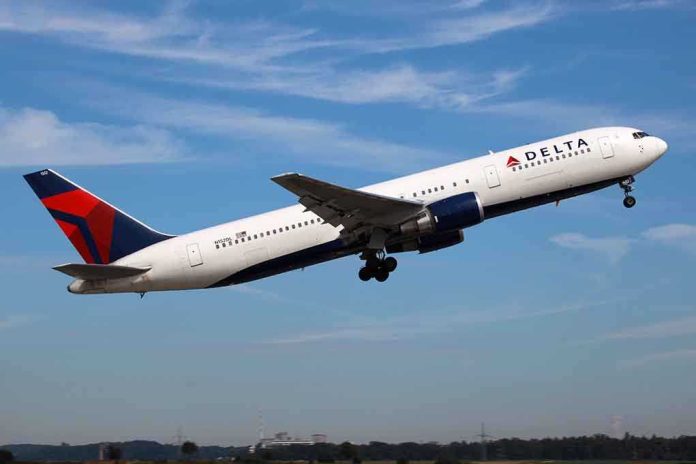
A 2,000-mile airline detour—triggered by a pilot’s medical emergency—spotlights how operational priorities can override common-sense efficiency, fueling new concerns about the cost and logic of major corporate decisions in today’s America.
Story Snapshot
- Delta Flight 389 diverted 2,000 miles to Los Angeles after a pilot fell ill, causing an eight-hour delay for passengers.
- The crew bypassed closer airports, opting for Delta’s LAX hub to facilitate crew replacement and operational continuity.
- The incident underscores the complexity and risks of long-haul flights over remote regions with limited diversion options.
- While safety protocols worked, the decision raises questions about efficiency, passenger impact, and industry contingency planning.
Delta’s 2,000-Mile Detour: Safety or Corporate Convenience?
Delta Air Lines Flight 389, traveling from Detroit to Shanghai in August 2025, was forced to divert to Los Angeles after one of its pilots became seriously ill mid-flight. Instead of landing at the nearest suitable airport, the remaining crew flew the Airbus A350 approximately 2,000 miles south to Delta’s LAX hub—adding about eight hours to the journey and leaving passengers stranded on the ground for three and a half hours. This decision, while ensuring operational continuity and rapid crew replacement, left many questioning whether passenger interests or corporate logistics took priority.
Delta flight takes 2,000-mile detour after pilot fell ill — adding 8 hours to journey https://t.co/X7UCXLEW70 pic.twitter.com/buaOhrLrA0
— New York Post (@nypost) September 1, 2025
Such a lengthy diversion highlights the unique challenges of ultra-long-haul flights that cross remote northern airspace, where available airports are few and far between. Airlines maintain strict protocols for medical emergencies, but in this instance, Delta’s choice to bypass closer options in favor of its own hub at LAX reflects a deliberate strategy. While this approach streamlines the process of crew replacement and maintenance, it also underscores the tension between maximizing corporate efficiency and minimizing passenger disruption—especially when travelers face missed connections and long delays as a result.
Operational Protocols and Passenger Impact
The crew’s immediate response to the incapacitated pilot demonstrates the importance of established safety measures in aviation. Delta prioritized getting the affected crew member the necessary medical care and ensuring the flight could continue safely. Air Traffic Control and Los Angeles International Airport provided essential support, facilitating a seamless and incident-free landing. However, passengers endured significant inconvenience, waiting hours on the tarmac before a replacement crew arrived. The delays not only tested travelers’ patience but also added unforeseen costs and complications, such as missed connections and disrupted schedules.
From an economic standpoint, this type of diversion is costly. Direct expenses for fuel, logistics, and passenger compensation can quickly escalate into the millions, putting additional strain on airline finances during an era already marked by inflation and operational challenges. Although no injuries or further complications were reported, the event serves as a reminder of the delicate balance between ensuring safety, maintaining efficiency, and respecting customer experience—especially as airlines increasingly operate ultra-long-haul routes over sparsely populated regions.
Industry Lessons: Contingency Planning and Future Implications
Aviation experts agree that the decision to divert to a hub like LAX, rather than the nearest available airfield, is not without precedent. Such choices are often calculated trade-offs, weighing the immediate needs of crew and passengers against long-term operational continuity. In this case, Delta’s approach ensured a rapid crew swap and access to maintenance resources, but it also brought to light the risks and vulnerabilities associated with long-distance air travel. The incident is expected to prompt a renewed focus on crew health monitoring and contingency planning, as airlines grapple with the logistical hurdles of flying over remote and infrastructure-poor regions.
For travelers, the takeaway is clear: while airline safety systems are robust, passengers can still be caught in the crossfire of decisions that prioritize corporate logistics over individual convenience. For the industry, the incident underscores the continued importance of operational resilience and the strategic use of hub airports. As the frequency of ultra-long-haul flights increases, both airlines and regulators will face mounting pressure to ensure that contingency plans serve not just the bottom line, but also the interests of the flying public—and, by extension, the principles of transparency and accountability that Americans expect.
Sources:
Delta flight diverts 2,000 miles to LA after pilot falls ill
U.S. flight diversions 2025 timeline
Delta flight takes 8-hour detour after pilot falls ill







